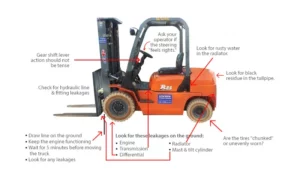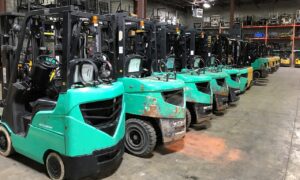Forklift safety encompasses the policies, procedures, and practices implemented to prevent accidents and injuries in environments where forklifts are used. Ensuring their safe operation is paramount, given their critical role in material handling across various industries.
This article explores the concept of forklift safety, its importance, and how it can be effectively implemented to create a safer workplace.
The Importance of Forklift Safety
The significance of forklift safety cannot be overstated. In addition to the apparent priority of protecting human life, forklift safety has several other benefits:
- Reduces Operational Costs: Accidents can be costly, resulting in damaged goods, equipment repair, and potential legal liabilities.
- Improves Productivity: A safe work environment boosts employee morale and efficiency, as workers are more focused and less prone to accidents.
- Ensures Compliance: Adhering to safety regulations helps avoid fines and penalties associated with non-compliance.
Key Elements of Forklift Safety
The key elements for successfully conducted forklift safety are as follows:
Comprehensive Training
Training is the cornerstone of forklift safety. Operators must undergo thorough training covering the operation, safety practices, and workplace-specific hazards. This training should be ongoing, with regular refreshers to ensure skills and knowledge are up-to-date.
Regular Maintenance and Inspections
Forklifts should be regularly inspected and maintained according to the manufacturer’s recommendations and regulatory requirements. This includes daily checks for issues that could affect safety, such as tire condition, brake function, and the integrity of safety devices.
Safe Operating Procedures
Developing and enforcing safe operating procedures is essential. This includes defining speed limits, load capacities, and rules for navigating around pedestrians. Procedures should be tailored to the specific conditions and layout of each workplace.
Workplace Design
The workplace design plays a significant role in forklift safety. Aisles should be wide enough to accommodate forklift traffic, with clear visibility at intersections and designated pedestrian-traffic areas. Signage and physical barriers can also help prevent accidents.
Implementing Forklift Safety
Implementing an effective forklift safety program requires commitment from all levels of an organization. Here are some steps to consider:
- Conduct a Risk Assessment: Identify potential hazards for forklift operations in your specific environment.
- Develop a Safety Plan: Based on the risk assessment, create a comprehensive safety plan that includes training, maintenance, and operating procedures.
- Provide Adequate Training: Ensure all forklift operators are properly trained and certified. Include training for non-operators who work in areas where forklifts are used.
- Implement Safety Measures: Put in place physical safety measures, such as barriers, warning signs, and floor markings.
- Monitor and Review: Review accidents and near misses regularly to identify areas for improvement. Adjust the safety plan as necessary to address new hazards or changes in the workplace.
The Role of Technology in Forklift Safety
Integrating technology into forklift safety measures marks a significant evolution in how industries approach the prevention of accidents and the protection of workers. Technological advancements have paved the way for innovative safety features that augment traditional safety practices and introduce a new layer of protection in material handling environments. These technological solutions range from sophisticated sensor systems to software applications, each designed to address specific safety challenges associated with forklift operations.
One of the most impactful technological innovations in forklift safety is the development of anti-collision systems. These systems utilize sensors and cameras to detect the presence of objects or personnel in the forklift’s path, automatically slowing down or stopping the forklift to prevent a collision. This capability is particularly valuable in busy warehouses where visibility may be limited, and the risk of accidents is higher. Similarly, stability monitoring systems have been developed to assess tip-over risk—a common and dangerous occurrence with forklifts. These systems can alert operators to instability issues before they lead to accidents by analyzing load weight, height, and the forklift’s movements.
Speed control technology represents another significant advancement in forklift safety. By automatically regulating its speed based on its location within the facility, such technology ensures that forklifts do not exceed safe speeds, particularly in areas with high pedestrian traffic or tight spaces. This reduces the likelihood of collisions and helps maintain a controlled environment where both forklift operators and pedestrians can safely coexist.
Beyond hardware, software solutions have also emerged as critical tools in enhancing forklift safety. Fleet management software, for example, can track forklift operations in real-time, monitoring safety compliance and identifying patterns that may indicate potential risks. Such software can also facilitate the delivery of targeted training programs, ensuring operators are educated on the latest safety protocols and best practices. Wearable technology, like smart watches and vests, can monitor operator alertness and provide immediate feedback on unsafe behaviors, further embedding safety into daily operations.
Forklift safety is critical to industrial safety, requiring a proactive and comprehensive approach to prevent accidents and injuries. Organizations can significantly reduce the risks associated with forklift operations by emphasizing training, maintaining equipment, enforcing safe operating procedures, and designing workplaces with safety in mind. As technology evolves, forklift safety technology companies such as Trio Mobil offer additional tools to enhance safety measures. Ultimately, the goal of forklift safety is to create a work environment where accidents are rare, and employees can perform their duties without fear of injury, contributing to the overall success and productivity of the business.



































